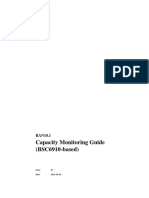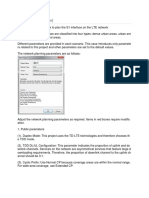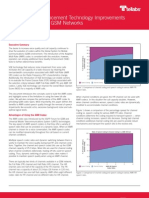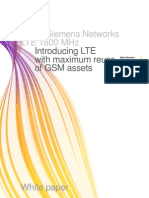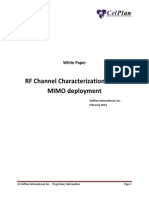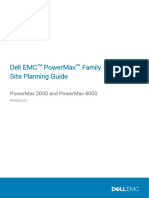LTE RF Planning
LTE RF Planning
Uploaded by
Sham DegiggsyCopyright:
Available Formats
LTE RF Planning
LTE RF Planning
Uploaded by
Sham DegiggsyCopyright
Available Formats
Share this document
Did you find this document useful?
Is this content inappropriate?
Copyright:
Available Formats
LTE RF Planning
LTE RF Planning
Uploaded by
Sham DegiggsyCopyright:
Available Formats
http://sites.google.com/site/lteencyclopedia/lte-radio-link-budgeting-and...
LTE Radio Link Budgeting and RF Planning >
LTE RF Planning
Contents 1 Introduction 2 Phase 1: Initial RF Link Budget 3 Phase 2: Detailed RF Propagation 4 Phase 3: Fine Tuninig and Optimisation 5 Phase 4: Continuous Optimisation
After initial link budget estimations, the next phase is the RF Planning of the LTE Radio Access Network (RAN). RF Planning is a complex and iterative process that includes but is not limited to a number of stages. Each of these stages is defined below in detail.
Introduction
In the context of mobile and cellular communication systems, RF Planning is the process of assigning frequencies, transmitter locations and parameters of a wireless communications system to provide sufficient coverage and capacity for the services required (e.g. mobile telephony). The RF plan of a cellular communication system revolves around two principal objectives; Coverage and Capacity Coverage relates to the geographical footprint within the system that has sufficient RF signal strength to provide for a call/data session. Capacity relates to the capability of the system to sustain a given number of subscribers. In 3GPP LTE systems, both capacity and coverage are interrelated. To improve quality some coverage, capacity has to be sacrificed, while to improve capacity, coverage will have to be sacrificed. The LTE RF planning process mainly consists four phases:
Phase 1: Initial RF Link Budget
The first level of the RF planning process is a budgetary level. It uses the RF link budget along with a statistical propagation model (e.g. Hata, COST-231 Hata or Erceg-Greenstein) to approximate the coverage area of the planned sites and to eventually determine how many sites are required for the particular RF communication system. The statistical propagation model does not include terrain effects and has a slope and intercept value for each type of environment (Rural, Urban, Suburban, etc.). This fairly simplistic approach allows for a quick analysis of the number of sites that may be required to cover a certain area. Following is a typical list of outputs produced at this stage: Estimated Number of Sites
Phase 2: Detailed RF Propagation Modelling
The second level of the RF Planning process relies a more detailed propagation model. Automatic planning tools are often employed in this phase to perform detailed predictions. The propagation model takes into account the characteristics of the selected antenna, the terrain, and the land use and land clutter surrounding each site. Since these factors are considered, this propagation model provides a better estimate of the coverage of the sites than the initial statistical propagation model. Thus, its use, in conjunction with the RF link budget, produces a more accurate determination of the number of sites required. Following is a typical list of outputs produced at this stage: Number of Sites and Site Locations (and Height) Antenna Directions and Downtilts Neighbour Cell Lists for each site Mobility (Handover and Cell Reselection) Parameters for each site. Frequency Plan Detailed Coverage Predictions (e.g. Signal Strength (RSRP), Signal Quality (RSRQ) Best CINR, Best Server Areas, Uplink and Downlink Throughput) The following figure shows a typical coverage prediction out (All Sites coverage by Signal Strength).
1 of 2
26/09/2011 10:06 PM
http://sites.google.com/site/lteencyclopedia/lte-radio-link-budgeting-and...
Figure 1: Sites Coverage by Signal Strength
Phase 3: Fine Tuninig and Optimisation
The third phase of the RF planning process incorporates further detail into the RF plan. This stage includes items such as collecting drive data to be used to tune or calibrate the propagation prediction model, predicting the available data throughput at each site, fine tuning of parameter settings (e.g. antenna orientation, downtilting, frequency plan). This process is required in the deployment of the system or in determining service contract based coverage. Following is a typical list of outputs produced at this stage: A final List of Sites and Site Locations (and Height) Optimised Antenna Directions and Downtilts An optimised Neighbour Cell Lists for each site Mobility (Handover and Cell Reselection) Parameters for each site. An optimised Frequency Plan Detailed Coverage Predictions (e.g. Signal Strength (RSRP), Signal Quality (RSRQ) Best CINR, Best Server Areas, Uplink and Downlink Throughput)
Phase 4: Continuous Optimisation
The final phase of the RF planning process involves continuous optimisation of the RF plan to accommodate for changes in the environment or additional service requirements (e.g. additional coverage or capacity). This phase starts from initial network deployment and involves collecting measurement data on a regular basis that could be via drive testing or centralised collection. The data is then used to plan new sites or to optimize the parameter settings (e.g. antenna orientation, downtilting, frequency plan) of existing sites.
2 of 2
26/09/2011 10:06 PM
You might also like
- TCH & SDCCH Congestion AnalysisDocument4 pagesTCH & SDCCH Congestion AnalysisAbdur RazzaqeNo ratings yet
- 5G RAN2.0 Radio Network Planning Guide - 20180720Document89 pages5G RAN2.0 Radio Network Planning Guide - 20180720Ram Kumar Sharma100% (6)
- LTE Self-Organising Networks (SON): Network Management Automation for Operational EfficiencyFrom EverandLTE Self-Organising Networks (SON): Network Management Automation for Operational EfficiencySeppo HämäläinenNo ratings yet
- Radio Spectrum Management: Policies, Regulations and TechniquesFrom EverandRadio Spectrum Management: Policies, Regulations and TechniquesNo ratings yet
- SYSTEM Info (L3 Messages) 2GDocument43 pagesSYSTEM Info (L3 Messages) 2GWuhayb Mohsin MirzaNo ratings yet
- Nastar Network Optimization User Guide (UMTS) - (V600R009 - 01) (PDF) - enDocument437 pagesNastar Network Optimization User Guide (UMTS) - (V600R009 - 01) (PDF) - enSeby SebykNo ratings yet
- Capacity Monitoring Guide - R18Document62 pagesCapacity Monitoring Guide - R18didin mansyurNo ratings yet
- 3g Inteference Test and Solution ReportDocument10 pages3g Inteference Test and Solution ReportRussell OsiNo ratings yet
- RTWP IssueDocument4 pagesRTWP Issueekoyudip1No ratings yet
- Eeee Eeeee Eeeeeeeee Eee Eeeeee-Eeee Feef: EeeeeeeeeeeDocument27 pagesEeee Eeeee Eeeeeeeee Eee Eeeeee-Eeee Feef: EeeeeeeeeeetaulanberishaNo ratings yet
- 2.1 Define: Random Access (RACH) SuccessDocument4 pages2.1 Define: Random Access (RACH) SuccesspranayesquireNo ratings yet
- Signal Perameters (RSSI, RSRQ & SINR in LTE)Document4 pagesSignal Perameters (RSSI, RSRQ & SINR in LTE)Usman NomaniNo ratings yet
- CDMA RF Planning GuideDocument460 pagesCDMA RF Planning Guidemohitverma2411100% (1)
- UMTS Interview Questions and AnswerDocument16 pagesUMTS Interview Questions and AnswerSuhelSiddiquiNo ratings yet
- OWO300050 WCDMA Abnormal Interference Problem Analysis ISSUE 1.00Document71 pagesOWO300050 WCDMA Abnormal Interference Problem Analysis ISSUE 1.00riamaNo ratings yet
- Layer 3 - Umts PDFDocument49 pagesLayer 3 - Umts PDFSukrit Chaudhary100% (6)
- CCNP Ospf FinalDocument81 pagesCCNP Ospf FinalMarcelo MoreiraNo ratings yet
- 02 01 Rn33022en10gla00 Cs Call SetupDocument56 pages02 01 Rn33022en10gla00 Cs Call SetupAbd El-Rahman Essam AnisNo ratings yet
- Reducing The Effects of Ping-Pong Handover inDocument10 pagesReducing The Effects of Ping-Pong Handover inSarsij MishraNo ratings yet
- CV Manish - LTE OPtimization-UpdatedDocument5 pagesCV Manish - LTE OPtimization-UpdatedManish SoniNo ratings yet
- RTWP ExperienceDocument2 pagesRTWP ExperienceoptimiNo ratings yet
- Wcdma Ran HandoverDocument22 pagesWcdma Ran Handoverİsmail AkkaşNo ratings yet
- 2GDocument7 pages2Gjitu_rfNo ratings yet
- HCIP-LTE-RNP - RNO V1.0 Exam OutlineDocument6 pagesHCIP-LTE-RNP - RNO V1.0 Exam OutlineSemirNo ratings yet
- LTE KPI Optimization - RRC Success RateDocument6 pagesLTE KPI Optimization - RRC Success RateAnway MohantyNo ratings yet
- EDX WP Int MC Plan Using EDX SignalPro PDFDocument7 pagesEDX WP Int MC Plan Using EDX SignalPro PDFMustaf MohamedNo ratings yet
- RACH ShareTechnoteDocument37 pagesRACH ShareTechnoteRajeev Ranjan KumarNo ratings yet
- Capacity Case Study - ShortenedDocument11 pagesCapacity Case Study - Shortenedcyo3fff100% (1)
- HSUPADocument35 pagesHSUPAAlp Akbulut100% (1)
- 2G-3G Cell Reselection AlcatelDocument10 pages2G-3G Cell Reselection AlcatelMahmoud AliNo ratings yet
- Bandwidth CalculationDocument3 pagesBandwidth CalculationAriev IkankNo ratings yet
- Tems Log-File AnalysisDocument36 pagesTems Log-File AnalysisasadNo ratings yet
- LTE - RF Operational ParametersDocument23 pagesLTE - RF Operational Parametersnetman_84No ratings yet
- 2.modul - Drive Test AnalystDocument165 pages2.modul - Drive Test AnalystDentNo ratings yet
- RX Level Definition: 1. RxlevelDocument9 pagesRX Level Definition: 1. Rxlevelabhinav268No ratings yet
- EIGRPDocument102 pagesEIGRPNguyễn Mạnh ThếNo ratings yet
- GSM RF Optimization GuidelinesDocument96 pagesGSM RF Optimization Guidelinesnabilalhamdani100% (3)
- Antenna Tilt: Mechanical Vs Electrical: August 12, 2017 Admin RF BasicsDocument21 pagesAntenna Tilt: Mechanical Vs Electrical: August 12, 2017 Admin RF BasicsHuy LieuNo ratings yet
- Huawei GU900 Refarming Solution For Thai Nguyen 20140512 PDFDocument17 pagesHuawei GU900 Refarming Solution For Thai Nguyen 20140512 PDFPhong KimNo ratings yet
- Mentum Planet 5 (1) .0 LTE MP501Document49 pagesMentum Planet 5 (1) .0 LTE MP501Yousuf ShaikhNo ratings yet
- 07 - LTE Mobility ManagementDocument59 pages07 - LTE Mobility ManagementAnonymous Bqwv6CdNo ratings yet
- 3 LTE Cell Planning ISSUE1.10Document60 pages3 LTE Cell Planning ISSUE1.10Ahmedoozziee MohammedNo ratings yet
- H2 Handover Scheme LTE RDocument8 pagesH2 Handover Scheme LTE RFirmansyah KobongsatuNo ratings yet
- OSPF Design Terminologies: (1) - ABR (Area Border Router) (2) - ASBR (Autonomous System Border Router)Document7 pagesOSPF Design Terminologies: (1) - ABR (Area Border Router) (2) - ASBR (Autonomous System Border Router)Anurag YadavNo ratings yet
- What Are Main Reasons of Low Throughout in 4G LTEDocument2 pagesWhat Are Main Reasons of Low Throughout in 4G LTEazkaNo ratings yet
- AMR AdvantagesDocument4 pagesAMR AdvantagesAjosh RajuNo ratings yet
- Basic 3G ParametersDocument5 pagesBasic 3G ParametersUmair SiddiqueNo ratings yet
- NSN Lte 1800 MHZ White Paper - 0.9Document11 pagesNSN Lte 1800 MHZ White Paper - 0.9schabrackentapirNo ratings yet
- LTE FDD RF Optimization Methods & ProceduresDocument225 pagesLTE FDD RF Optimization Methods & ProceduresHtet Aung LynnNo ratings yet
- NSN 3G RF Engineer Questionnaire - V1Document4 pagesNSN 3G RF Engineer Questionnaire - V1brian3gNo ratings yet
- Call Admission Control (RAN13.0 - 02)Document57 pagesCall Admission Control (RAN13.0 - 02)Carlos Jose RodriguezNo ratings yet
- EcNo Criteria For CS IRATDocument13 pagesEcNo Criteria For CS IRATQasim Abbas AlviNo ratings yet
- Eul (Hsupa)Document27 pagesEul (Hsupa)Sumon Kumar BiswasNo ratings yet
- Fast WCDMA Reselection at 2G CS Call Release Feature Delivery GuideDocument17 pagesFast WCDMA Reselection at 2G CS Call Release Feature Delivery GuideabojablNo ratings yet
- KPIDocument7 pagesKPIKunal GuptaNo ratings yet
- GSM HoppingDocument15 pagesGSM HoppingKamil KocNo ratings yet
- RF Channel Characterization For 4G MIMO Deployments Rev9Document46 pagesRF Channel Characterization For 4G MIMO Deployments Rev9sugadoorNo ratings yet
- GSM Layer 3 MessagesDocument47 pagesGSM Layer 3 MessagesKrishnakumar VoletiNo ratings yet
- SDNDocument25 pagesSDNTito NugrohoNo ratings yet
- IMC UAV ReceieversDocument8 pagesIMC UAV ReceieverssaurabhpachNo ratings yet
- DEH-1820R DEH-1800R: Operation Manual Mode DemploiDocument106 pagesDEH-1820R DEH-1800R: Operation Manual Mode DemploiAlexander CaraballoNo ratings yet
- Dokumen - Tips L Epstein Relativity VisualizedDocument246 pagesDokumen - Tips L Epstein Relativity Visualizedshantanu.deo.photos4No ratings yet
- FM Stereo FM/AM Receiver: STR-DE698Document64 pagesFM Stereo FM/AM Receiver: STR-DE698Razvan BurlacuNo ratings yet
- Nokia 6090 Nme-3 PDFDocument373 pagesNokia 6090 Nme-3 PDFЙордан ЙордановNo ratings yet
- Lte Cell RadiusDocument4 pagesLte Cell RadiusSana Ullah100% (1)
- TX 25 Plus - TX 250 Plus1Document2 pagesTX 25 Plus - TX 250 Plus1guestisor100% (1)
- Adc 883 PDFDocument6 pagesAdc 883 PDFAngel GuzmánNo ratings yet
- Eee Undergraduate Project Abstracts 2 PDFDocument49 pagesEee Undergraduate Project Abstracts 2 PDFMuhammad Ali HafeezNo ratings yet
- ECE 421 Lab4Document39 pagesECE 421 Lab4LuelsonCordovaDeclaradorNo ratings yet
- David Barker - Quintel - Base Station Antenna InnovationDocument19 pagesDavid Barker - Quintel - Base Station Antenna Innovationstere_c23No ratings yet
- RF 678 MergedDocument588 pagesRF 678 MergedpowerinfiniteNo ratings yet
- Kboseinn PDF 1572082769Document55 pagesKboseinn PDF 1572082769Mark McKinsnkeyNo ratings yet
- Model 3 Keycard ManualDocument5 pagesModel 3 Keycard ManualFred Lamert100% (4)
- Microcontroller With IR SensorsDocument31 pagesMicrocontroller With IR Sensorsanishvancha100% (4)
- Full Download Phase Noise and Frequency Stability in Oscillators 1st Edition Enrico Rubiola PDF DOCXDocument52 pagesFull Download Phase Noise and Frequency Stability in Oscillators 1st Edition Enrico Rubiola PDF DOCXzajemomchi100% (1)
- Docu88907 PowerMax Family Site Planning GuideDocument112 pagesDocu88907 PowerMax Family Site Planning GuideDocUploader22No ratings yet
- 003 Radar and ArpaDocument115 pages003 Radar and Arpacc telle100% (3)
- Media Release - Sbs Launches The Pop Asia ShowDocument3 pagesMedia Release - Sbs Launches The Pop Asia Showshare18No ratings yet
- OptiX RTN 600 Introduction-BDocument57 pagesOptiX RTN 600 Introduction-BRyan BlankenshipNo ratings yet
- Satellite HandbookDocument145 pagesSatellite Handbookwalelwi100% (6)
- Wpa-80080-4cf - 5°Document1 pageWpa-80080-4cf - 5°John DoeNo ratings yet
- Multipath and Receiver Models For Assessing The VOR Bearing ErrorDocument146 pagesMultipath and Receiver Models For Assessing The VOR Bearing ErrorYuranan LimpananvadeeNo ratings yet
- 4fsk DemodDocument4 pages4fsk DemodavionionNo ratings yet
- Experinment-2 of LabDocument3 pagesExperinment-2 of LabRohanNo ratings yet
- Wave Speed WorksheetDocument3 pagesWave Speed WorksheetYassin HafezNo ratings yet
- UMTS TutorialDocument84 pagesUMTS Tutorialnale_2100% (1)
- Radar System Components and System DesignDocument13 pagesRadar System Components and System DesignRaushan SinghNo ratings yet
- LTE RAN Parameters Ericsson SamsungDocument140 pagesLTE RAN Parameters Ericsson SamsungSri Datta Sameer Achanta100% (1)







